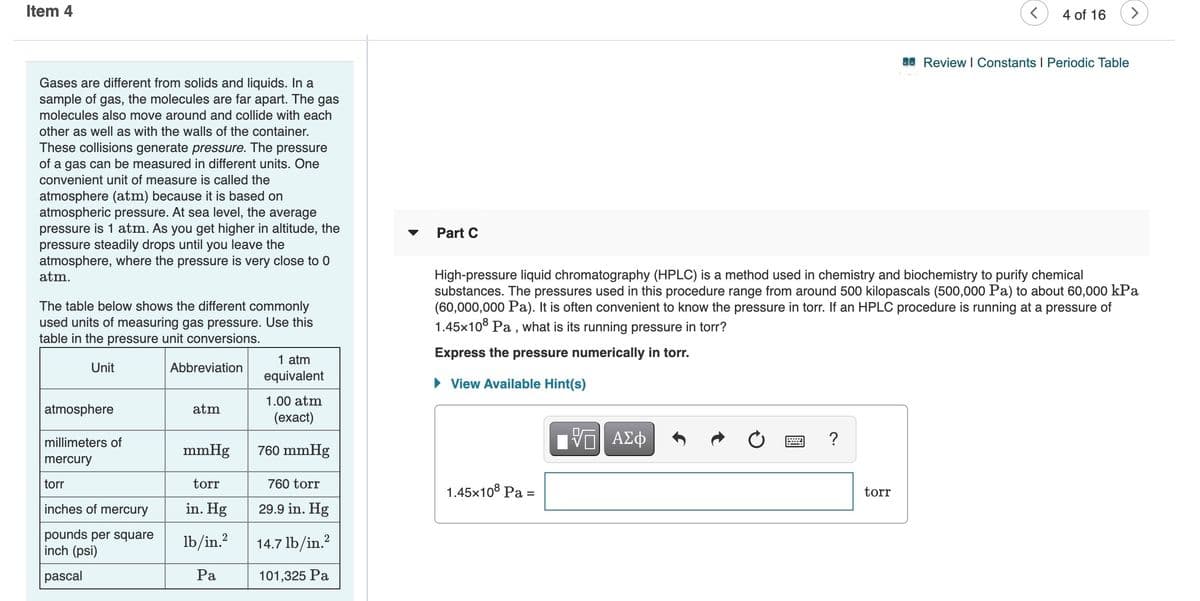High-pressure liquid chromatography (HPLC) is a method used in chemistry and biochemistry to purify chemical substances. The pressures used in this procedure range from around 500 kilopascals (500,000 Pa) to about 60,000 kPa (60,000,000 Pa). It is often convenient to know the pressure in torr. If an HPLC procedure is running at a pressure of 1.45x108 Pa , what is its running pressure in torr? Express the pressure numerically in torr.
High-pressure liquid chromatography (HPLC) is a method used in chemistry and biochemistry to purify chemical substances. The pressures used in this procedure range from around 500 kilopascals (500,000 Pa) to about 60,000 kPa (60,000,000 Pa). It is often convenient to know the pressure in torr. If an HPLC procedure is running at a pressure of 1.45x108 Pa , what is its running pressure in torr? Express the pressure numerically in torr.
Introductory Chemistry: A Foundation
9th Edition
ISBN:9781337399425
Author:Steven S. Zumdahl, Donald J. DeCoste
Publisher:Steven S. Zumdahl, Donald J. DeCoste
Chapter13: Gases
Section: Chapter Questions
Problem 104AP
Related questions
Question
100%

Transcribed Image Text:Item 4
4 of 16
ae Review I Constants I Periodic Table
Gases are different from solids and liquids. In a
sample of gas, the molecules are far apart. The gas
molecules also move around and collide with each
other as well as with the walls of the container.
These collisions generate pressure. The pressure
of a gas can be measured in different units. One
convenient unit of measure is called the
atmosphere (atm) because it is based on
atmospheric pressure. At sea level, the average
pressure is 1 atm. As you get higher in altitude, the
pressure steadily drops until you leave the
atmosphere, where the pressure is very close to 0
atm.
Part C
The table below shows the different commonly
used units of measuring gas pressure. Use this
table in the pressure unit conversions.
High-pressure liquid chromatography (HPLC) is a method used in chemistry and biochemistry to purify chemical
substances. The pressures used in this procedure range from around 500 kilopascals (500,000 Pa) to about 60,000 kPa
(60,000,000 Pa). It is often convenient to know the pressure in torr. If an HPLC procedure is running at a pressure of
1.45x10° Pa , what is its running pressure in torr?
1 atm
Express the pressure numerically in torr.
Unit
Abbreviation
equivalent
• View Available Hint(s)
1.00 atm
atmosphere
atm
(ехact)
millimeters of
ΑΣφ
?
mmHg
760 mmHg
mercury
torr
torr
760 torr
1.45x108 Pa =
torr
inches of mercury
in. Hg
29.9 in. Hg
pounds per square
inch (psi)
lb/in.?
2
14.7 lb/in.?
pascal
Pa
101,325 Pa
Expert Solution
This question has been solved!
Explore an expertly crafted, step-by-step solution for a thorough understanding of key concepts.
This is a popular solution!
Trending now
This is a popular solution!
Step by step
Solved in 2 steps

Knowledge Booster
Learn more about
Need a deep-dive on the concept behind this application? Look no further. Learn more about this topic, chemistry and related others by exploring similar questions and additional content below.Recommended textbooks for you

Introductory Chemistry: A Foundation
Chemistry
ISBN:
9781337399425
Author:
Steven S. Zumdahl, Donald J. DeCoste
Publisher:
Cengage Learning

Chemistry by OpenStax (2015-05-04)
Chemistry
ISBN:
9781938168390
Author:
Klaus Theopold, Richard H Langley, Paul Flowers, William R. Robinson, Mark Blaser
Publisher:
OpenStax

Chemistry: An Atoms First Approach
Chemistry
ISBN:
9781305079243
Author:
Steven S. Zumdahl, Susan A. Zumdahl
Publisher:
Cengage Learning

Introductory Chemistry: A Foundation
Chemistry
ISBN:
9781337399425
Author:
Steven S. Zumdahl, Donald J. DeCoste
Publisher:
Cengage Learning

Chemistry by OpenStax (2015-05-04)
Chemistry
ISBN:
9781938168390
Author:
Klaus Theopold, Richard H Langley, Paul Flowers, William R. Robinson, Mark Blaser
Publisher:
OpenStax

Chemistry: An Atoms First Approach
Chemistry
ISBN:
9781305079243
Author:
Steven S. Zumdahl, Susan A. Zumdahl
Publisher:
Cengage Learning


Chemistry
Chemistry
ISBN:
9781305957404
Author:
Steven S. Zumdahl, Susan A. Zumdahl, Donald J. DeCoste
Publisher:
Cengage Learning

Chemistry: The Molecular Science
Chemistry
ISBN:
9781285199047
Author:
John W. Moore, Conrad L. Stanitski
Publisher:
Cengage Learning